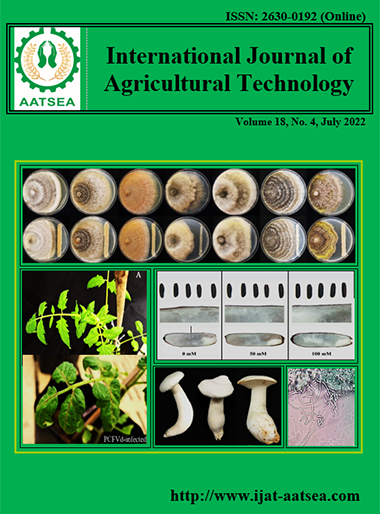Physical properties and nutritional value of durian juice produced from durian chips by-products
Main Article Content
Abstract
One of the most popular of the processed durian as durian chips which is being widely consumed in Thailand. There are many by-products and wastes in the process such as flesh, shell, and seeds. Those utilization is important for product development with economic value and decreasing environmental problems. Durian juice was firstly formulated from flesh and water at a ratio of 1:5. The different amounts of ripe durian flesh (0, 5, 10, 15, and 20%) on the physical properties such as color value (L*, a*, and b*), viscosity, and sensory attributes of durian juice were studied. An increase in the amount of ripe durian flesh resulted in the increased L* and b* color values (p<0.05). Moreover, the viscosity of durian juice tended to increase with the higher amount of ripe durian flesh used. Sensory attributes as evaluated using the 9-point hedonic scale showed that consumers rated with the maximum overall acceptability of 7.08 for the formulation with 15% ripe durian flesh. This durian juice formulation had a pH of 6.6, a total soluble solid of 8.3 °Brix, a viscosity of 73.0 cP, and antioxidant activity as analyzed using DPPH assay of 4.07%. The chemical compositions and nutritional value of the final product (15% ripe durian flesh) were investigated. It contained 6.33% carbohydrate, 0.29% protein, 0.1% fat, 1.96% fiber, 0.24% ash, 0% cholesterol, 21.81 mg/100g calcium, 0.036 mg/100g vitamin B1, and 37.15 kCal/100g. The results indicated that durian juice produced from the waste flesh in durian chip processing is a good source of many important substances, especially fiber and calcium
Article Details

This work is licensed under a Creative Commons Attribution-NonCommercial-NoDerivatives 4.0 International License.
References
AOAC (2019). Official methods of analysis of AOAC International, 21st edn., Association of Analytical Communities, Rockville, Maryland, USA.
Ashraf, M. A., Jamil Maah, M. and Yusoff, I. (2010). Estimation of Antioxidant Phytochemicals in Four Different Varities of Durian (Durio zibethinus murray) Fruit. Middle-East Journal of Scientific Research, 6:465-471.
Bourneow, C. and Santimalai, S. (2016). Process Optimization for Microbial Reduction in Durian Juice by Using Pulsed Electric Field. Journal of Science and Technology Mahasarakham University, 35:619-625.
Charoenphun, N. and Kwanhian, W. (2018). Effect of Flour from Durian Waste on Quality of Gluten Free Pasta. Thai Science and Technology Journal, 26:803-814.
Charoenphun, N., Setarnawat, S. and Sai-Ut, S. (2018). Chemical Composition and Trends in Utilization of By-products and Wastes from 4 Types of Tropical Fruit Processing. Thai Science and Technology Journal (TSTJ), 28:113-128.
Charoensuk, K., Wongekalak, L., Mongkontanawat, N., Nonmoung, W., Suwanposri, A, Tanmanee, P. and Kongsuk, M. (2018). Formulation, Sensory and Pulp Stability of Durian (Durio zibethinus Murr) Juice. International Journal of Agricultural Technology, 13:1437-1447.
Chin, S. T., Hamid, N. S. A., Quek, S. Y., Che Man, Y. B., Rahman, R. A. and Hashim, D. M. (2008). Changes of volatiles attribute in durian pulp during freeze- and spray drying process. Food Science and Technology, 41:1899-1905.
Daniel, R. S., Ismail, A. A., Winn, T. and Wolever, T. (2008). Glycemic index of common Malaysian fruits. Asia Pacific Journal of Clinical Nutrition, 17:35-39.
Jun, T. Y., Arumugam, S. D., Latip, N. H. A., Abdullah, A. M. and Latif, P. A. (2010). Effect of activation temperature and heating duration on physical characteristics of activated carbon prepared from agriculture waste. Environment Asia, 3:143-148.
Lee, H. H. and Rajeev, B. (2015). Exploring the potential nutraceutical values of durian (Durio zibethinus L.) -An exotic tropical fruit. Food Chemistry, 168:80-89.
Lim, T. K. (2012). Edible medicinal and non-medicinal plants (Vol. 1). Dordrecht Heidolberg, New York: Springer.
Manurakchinakorn, S., Chainarong, Y. and Sawatpadungkit, C. (2016). Quality of mangosteen juice colored with mangosteen pericarp. International Food Research Journal, 23:1033-1039.
Mirhosseini, H., Rashid, N. F. A., Amid, B. T., Cheong, K. W., Kazemi, M. and Zulkurnain, M. (2015). Effect of partial replacement of corn flour with durian seed flour and pumpkin flour on cooking yield, texture properties, and sensory attributes of gluten free pasta, LWT - Food Science and Technology, 63:184-190.
Norjana, I. and Noor Aziah, A. A. (2011). Quality attributes of durian (Durio zibethinus Murr) juice after pectinase enzyme treatment. International Food Research Journal, 18:1117-1122.
Purnomo, A., Yudiantoro, Y. A. W., Putro, J. N., Nugraha, A. T., Irawaty, W. and Ismadji, S., (2016). Subcritical water hydrolysis of durian seeds waste for bioethanol production. International Journal of Industrial Chemistry, 7:29-37.
Rusmiati, R., Ashari, S., Widodo, M. A. and Bansir, L. (2015). The nutritional composition of red durians from banyuwangi, Indonesia. Food Science and Quality Management, 37:46-51.
Sullivan, D. M. and Carpenter, D. E. (1993). Methods of analysis for nutrition labeling. Journal of AOAC International, 76:106.
Tan, P. F., Ng, S. K., Tan, T. B., Chong, G. H. and Tan, C. P. (2019). Shelf-life determination of durian (Durio zibethinus) paste and pulp upon high-pressure processing. Food Research, 3:221-230.
Wisutiamonkul, A., Ampomah-Dwamena, C., Allan, A. C. and Ketsa, S. (2017). Carotenoid accumulation in durian (Durio zibethinus) fruit is affected by ethylene via modulation of carotenoid pathway gene expression. Plant Physiology and Biochemistry, 115:308-319.
Wisutiamonkul, A., Promdang, S., Ketsa, S. and Van Doorn, W. G. (2015). Carotenoids in durian fruit pulp during growth and postharvest ripening. Food Chemistry, 180:301-305.
Zhu, K., Zhou, H. and Qian, H. (2006). Antioxidant and free radical scavenging activities of wheat germ protein hydrolysates (WGPH) prepared with catalase. Process Biochemistry, 41:1296-1302.


